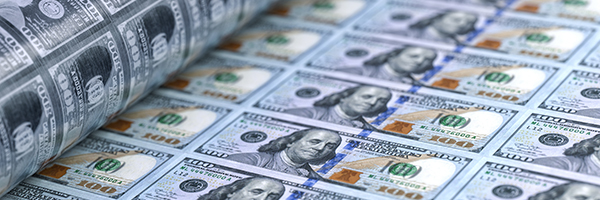The Standard & Poor’s 500 stock index may be closing in on the February 19 record closing high of 3386.15–about 11.2% from the Friday, May 29, close at 3044.31, but some Wall Street strategists see more rally ahead–with a close at the end of 2020 near 3,500 as a popular target. That’s even though unemployment is projected to climb to near 20% in May as the economy loses another 8 million jobs and as the economy is expected to contract at a shocking 30% to 40% annualized rate in the second quarter that ends on June 30.
Why the optimism that stocks can keep climbing from here? Why the faith that this rally hasn’t already price in full recovery n 2020?
Ahhh, the Federal Reserve.
The Fed has already added $3 trillion to its balance sheet, growing its assets to $7 trillion. But the Fed isn’t done, these strategists conclude. And they point to a measure called the market price/liquidity ratio, a measure that I’ve never seen cited before this rally, as a reason that stocks are in no danger of pulling back and are, instead, headed higher.
The market price liquidity ratio says that the Fed has pumped so much liquidity into the financial markets that there’s plenty of cash to push asset prices higher. On May 19 Bloomberg quoted a report from Michael Darda, chief economist and market strategist at MKM Partners, Darda citing the weekly price/liquidity ratio, which in compares the S&P 500 Index with the broadest measure of liquid money supply, called “money of zero maturity.” The latest reading was 0.14, below a average of 0.18 since 1990, according to Bloomberg data. That ratio says that stocks have further to run on the Fed’s liquidity efforts.)
And there’s more to come, these liquidity optimists argue.
The Fed won’t withdraw liquidity from the market any time soon, they say. The Fed’s recent speeches have “suggested” that it will continue current policy until it sees the labor market approaching full employment again with 2% inflation. With economists projecting that the current estimated unemployment rate will still be at 10% by the end of 2020, that could keep current liquidity programs in place until 2022. A formal acknowledgement of that policy guideline could come as early at the Fed’s June 10 meeting. (That meeting includes an update on the Fed’s projections for the U.S. economy so a formal change in policy guideline wouldn’t be unusual.) Prices for Eurodollar futures contracts are pointing to no interest rate increase from the current 0% to 0.25% range until 2023.
And the optimists’ expectations are that the Fed’s next move–maybe even at that June 10 meeting of the Fed’s Open Market Committee–will be to regularize the central bank’s current ad hoc bond buying program. “Liquidity optimists,” such as Goldman Sachs, believe the Fed will announce a pace of $80 billion to $120 billion a month in Treasury purchases bond purchases plus another $25 billion to $35 billion in purchases of mortgage-backed securities. That would be well north of the $75 billion a month in the Fed’s huge bond-buying program of $600 billion from November 2010 to June 2011 as part of the effort to jolt the economy into growth again after the Great Recession.
It looks like this belief in the Feds largesse is decreasing worries about the solvency of individual companies and increasing the market’s appetite for risk.For example, a Goldman Sachs basket of stocks with weaker balance sheets rose 4.3% this week, Bloomberg reports, nearly double the gain in a basket of stocks with healthier finances. Tuesday marked the widest gap in favor of the former basket since May 2009. The Russell 2000 small cap index also looks to be showing this effect. According to Credit Suisse, a third of small cap companies are expected to show losses in the June quarter with per-share profits are forecast to plummet 95%. But the Russell 2000 rose 6.4% in May, its best month versus the S&P 500 index in more than a year.
So how far will the Fed’s buying program go? I’ve seen recent projections that put the Fed’s balance sheet at $9 trillion to $10 trillion at its peak. Of course, no one knows if a $9 trillion Fed balance sheet is sustainable or whether it might in itself spook the financial markets.
“Interesting” from a risk/reward perspective when you note that the “liquidity optimists” are forecasting just an extra 15% gain from Friday’s close.


